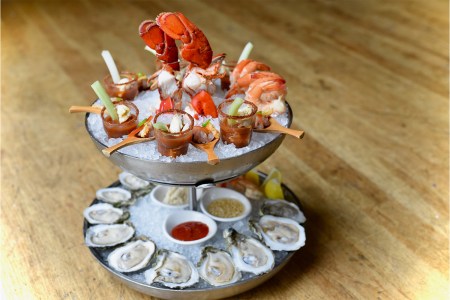There’s a new protein getting some age in meat lockers across America, and it’s not what you might expect. Sure, you’ve heard of dry-aged ribeye, dry-aged New York strip or even a dry-aged rack of lamb, but a dry-aged fish? Turns out, it’s all the rage, and for good reason.
In recent months, it seems as though eateries across the country — from omakase restaurant Friends Only in San Francisco to seafood-centric Cordelia’s in Washington, D.C. — have begun to highlight their dry-aging fish lockers and the delectable cuts of seafood inside them. But in reality, dry-aging is the correct way to store fish. “We have treated fish as if it had to be eaten ‘fresh’ for so long only because industrial storage methods were treating fish as if it was any other terrestrial commodity,” says Brian Bornemann of Crudo e Nudo in Santa Monica. “Yet fish does not come from our world and needs to be treated differently. For ages, cultures have been hanging fish because as soon as fish skin comes into contact with other surfaces, the body is triggered to start decomposition.”
As for the recent influx of fish lockers in restaurants, James Beard-winning chef Jeremiah Langhorne of Michelin-starred The Dabney and Petite Cerise attributes this to the excellent product that dry-aging yields.
“Dry-aging fish has moved into Western cooking within the past couple decades but has become much more noticeable in recent years because of the results dry-aging produces,” Langhorne says. And those results, perhaps unsurprisingly, are the same with fish as they are with other cuts of protein.
How to Build the Perfect Seafood Tower
Let Brennan’s of Houston show you the way“When you dry-age fish, it helps break down naturally-occurring enzymes, which creates a milder but more concentrated flavor and a butterier texture,” says Chico Dator, executive chef at Modan.
In its simplest form, dry-aging is exactly what it sounds like — a method of ditching moisture. “Moisture is just H20 and inherently flavorless,” Bornemann says. “Therefore, if the quality of the product doesn’t deteriorate and you lose water weight, your fish will inherently be more flavorful because it has less moisture. As a result, these dry-aged pieces of fish are perfect not only in raw preparations like sushi, crudo or carpaccio but also in simple cooked techniques, such as pan-searing or baking.

Just as with beef, lamb and other land-based proteins, there are plenty of fish varieties that are well-suited for dry-aging. Salmon is dry-aged at Cordelia’s, The Dabney is partial to its dry-aged rockfish and Modan dry-ages its tuna. And the larger the fish (and the higher the fat content), the longer it can stay in the locker. “The most important part of aging fish is making sure you’re sourcing the fish from a fisherman who is catching and storing them correctly until you receive them,” Langhorne says. This tends to mean the fisherman is adding as little water or ice as possible.
Unsurprisingly, that dry environment continues to be a factor in the actual meat locker or refrigerator. The reason you’ll see these specialized lockers in restaurants, Dator explains, is because they carefully control both humidity and temperature. “At Modan, we set the temperature close to freezing, which is basically the same temperature as the fish’s natural habitat,” he says. As a result, dry-aging your own fish or other proteins at home can be a bit taxing, as it demands precise conditions (and a lot of patience).
That said, Langhorne notes that “cost and quality control are the main benefits to dry-aging in-house.” And as the technology for dry-aging continues to improve day after day, expect to see a lot more dry-aged seafood on menus around the nation.
Join America's Fastest Growing Spirits Newsletter THE SPILL. Unlock all the reviews, recipes and revelry — and get 15% off award-winning La Tierra de Acre Mezcal.

























